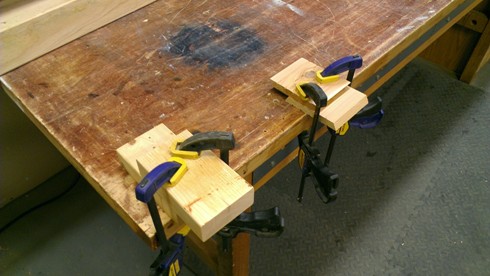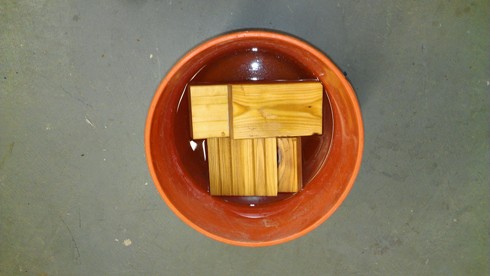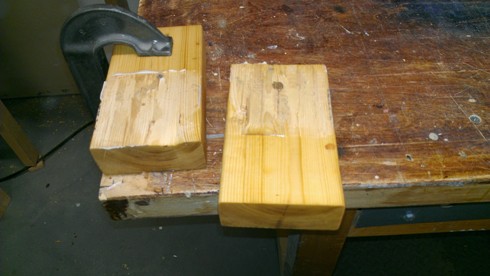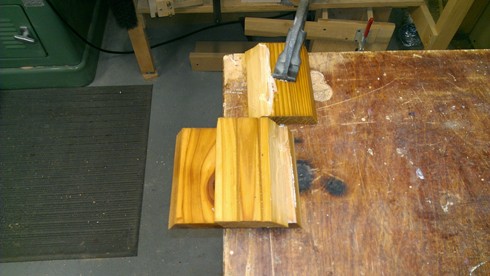While building some birdhouses that relied heavily on glue joints to keep the structure intact, I decided to try out Titebond III wood glue. This glue is advertised as being more waterproof than Titebond II, a popular glue for exterior projects that is designated as “water resistant” by the manufacturer, Franklin International. Comparing the labels for each product, Titebond II states that it is “weatherproof”, passes ANSI/HPVA Type II water-resistance standards, and it is designed for both interior and exterior applications – but not for continuous immersion or use below the water line. It also mentions that it is ideal for outdoor furniture, birdhouses, and planters. The Titebond III label states that it is waterproof, passes ANSI/HPVA Type I water resistance standards, and that it is not designed for continuous immersion or use below the water line.
Although the Titebond III label has no mention of birdhouses or other specific outdoor projects, one might conclude that Titebond III is a better choice for outdoor projects that are exposed to moisture. If you do a little digging, you’ll find that an ANSI/HPVA Type I rating means the bond is waterproof whereas an ANSI/HPVA Type II rating means the bond is water resistant. Titebond III is waterproof while Titebond II is merely water-resistant. And the newer Titebond III costs about 3 bucks more than the old school Titebond II. Has to be better, right?

Glued-up boards allowed to set for 24 hours
I’ll let someone else tackle that question. All I know is that I needed some decent exterior glue to hold some bird houses together and that I was curious to try out the relatively new Titebond III product. Given the project’s intricate glue-up procedures, the longer set time of Titebond III (8 minutes versus 5 minutes) was also appealing. So, I gave it a shot. But first I did a little test to give me some piece of mind that this glue was the real deal.

Glued together boards soaked in water for two days
The test involved two sets of scrap wood: the first set was two pine 2×4’s and the second set was two pieces of 3/4″ thick cedar. For each set, I glued and clamped the pieces together and allowed the glue to dry for 24 hours. Then I dropped each glued-together set into a bucket of water. The next day, I retrieved each set from the bucket and tried to break the glue joint by applying foot and hand pressure. The pieces didn’t budge. I threw each set back into the bucket and tried again the next day. This time, there was still no give using basic muscle strength so I decided to clamp each set to the work bench and then break the two pieces apart via other means. For the 2×4’s, I beat on the top board with a wooden mallet until the two pieces broke apart. Examining the break, it was apparent that the glue itself did not fail, but rather, the wood splintered. The glue did not dissolve, get tacky, or otherwise show signs of degrading.

Broken apart glue joint on 2 x 4 pine
For set two, the cedar boards, I pounded a screwdriver between the two boards with a mallet until the pieces separated. It took a bit of effort to achieve this separation. Again, the wood was the point of failure and not the glue. You can see from the photo that the wood itself split while the glue joint remained intact.

Broken apart glue joint on 3/4″ cedar
What did I learn from this highly scientific experiment? Well, I certainly came away impressed with Titebond III. If you’ve ever tried immersing boards in water that were glued together with ordinary wood glue, you know that the glue basically dissolves and the joint falls apart. The Titebond III glue showed no such signs of dissolving or failing. The label states that the glue is not designed for “continuous” immersion but I was hoping that it could withstand some immersion, perhaps similar to an outdoor item being subjected to several rainy days. I would say it did indeed do well in this regard. Of course, the acid test is whether the glue holds up over the long haul. For this “test”, I made several cedar birdhouses, gluing the various components together with a fresh bottle of Titebond III. I’ll let you know in a couple years if the glue passes the test!


Does glue still behave well on outdoor bird houses?
The glue is holding up well on the bird houses – they haven’t fallen apart yet!